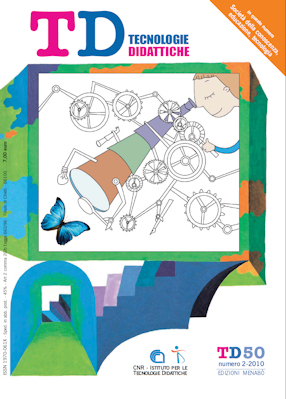Knowledge Society, Education, Technology
Main Article Content
Abstract
Article Details
Section
Authors who publish with this journal agree to the following terms:
- Authors retain copyright and grant the journal right of first publication with the work simultaneously licensed under a Creative Commons CC BY 4.0 Attribution 4.0 International License.
- Authors are able to enter into separate, additional contractual arrangements for the non-exclusive distribution of the journal's published version of the work (e.g., post it to an institutional repository or publish it in a book), with an acknowledgement of its initial publication in this journal.
- Authors are permitted and encouraged to post their work online (e.g., in institutional repositories or on their website) prior to and during the submission process, as it can lead to productive exchanges, as well as earlier and greater citation of published work (See The Effect of Open Access)
References
Bandura A. (1977). Self-efficacy: Toward a Unifying Theory of Behavioral Change. Psychological Review, 84(2), pp. 191-215.
Bjornavold J. (2001). Making learning visible: identification, assessment and recognition of non-formal learning. Vocational Training. European Journal, 22, pp. 24-32.
Boden M. (2001). Creativity and knowledge. In A. Craft, B. Jeffrey, M. Leibling (eds.). Creativity in Education. New York, London: Continuum, pp. 95-102.
Bottino R. M., Ferlino L., Ott M., Tavella M. (2007). Developing strategic and reasoning abilities with computer games at primary school level. Computers & Education, 49(4). Amsterdam: Elsevier, pp. 1272-1286.
Bruner J. (1993). La mente a più dimensioni. Roma; Bari: Laterza.
Cross J. (2006). Informal learning: rediscovering the natural pathways that inspire innovation and performance. San Francisco, CA: Pfeiffer.
Csikszentmihalyi M. (1997), Creativity: flow and the psychology of discovery and invention. London: Harper Perennial.
Dalke A., Cassidy K., Grobstein P., Blank D. (2007). Emergent pedagogy: learning to enjoy the uncontrollable and make it productive. Journal of Educational Change, 8(2), pp. 111-130.
Caviglia F., Ferraris M. (2008). The Web as a learning environment: focus on the content vs. focus on the search process. In M. Kendall, B. Samways (eds.). IFIP International Federation for Information Processing, 281, Learning to Live in the Knowledge Society. Boston: Springer, pp. 175–178.
Cunningham D.J., Arici A., Schreiber J., Lee K. (2001). Navigating the World Wide Web: the role of abductive reasoning. CRLT Technical Report, n.19-01, Indiana University, URL: http://streams.indiana.edu/publications/journals/TR19-01.pdf (ultima consultazione luglio 2010).
Delfino M. (2008). Rimestare nel torbido: allenare le capacità critiche ragionando su spam e phishing. TD-Tecnologie Didattiche, 45, pp. 48-51.
Ferrari A., Cachia R., Punie Y. (2009). Innovation and Creativity in Education and Training in the EU Member States: Fostering Creative Learning and Supporting Innovative Teaching. JRC Technical note, European Commission, URL: http://www.jrc.ec.europa.eu/ (ultima consultazione luglio 2010).
Garrison D. R., Anderson T., Archer W. (2000). Critical Inquiry in a Text-Based Environment: Computer Conferencing in Higher Education. The Internet and Higher Education, 2(2-3). Elsevier pp. 87-105, URL: http://communitiesofinquiry.com/files/Critical_Inquiry_model.pdf (ultima consultazione maggio 2010).
Gardner H. (1993). Creating minds: An anatomy of creativity seen through the lives of Freud, Einstein, Picasso, Stravinsky, Eliot, Graham, and Gandhi. New York: Basic Books.
Gardner H. (2007). Cinque chiavi per il futuro. Milano: Feltrinelli.
Grant R. (1996). Toward a knowledge-based theory of the firm. Strategic Management Journal, 17 (Special Issue), pp. 109-122.
Guildford J.P. (1963). Creativity. American Psychology, 9, pp. 444-454.
Hervàs Soriano F., Mulatero F. (2009). Connecting the Dots-How to Strengthen the EU Knowledge Economy. Joint Research Center, European Commission.
Jakes D. S., Pennington M. E., Knodle H. A. (2002). Using Internet to promote inquiry based learning, URL: http://www.jakesonline.org/ibr.htm (ultima consultazione luglio 2010).
McKenziÈs J. (2005). Learning to Question to Wonder to Learn. Bellingham: FNO Press.
Ministero Pubblica Istruzione (2007). Indicazioni per il curricolo per la scuola dell’infanzia e per il primo ciclo di istruzione – Roma, settembre 2007. Napoli: Tecnodid.
Morin E. (2000). La testa ben fatta - Riforma dell’insegnamento e riforma del pensiero nel tempo della globalizzazione. Milano: Cortina Editore.
Olimpo G. (1997). Le tecnologie dell’informazione per la didattica. In S. Bagnara, A. Failla (eds.). Compagno di banco. Milano: Etas Libri, pp. 3-23.
Olimpo G. (2004). Scuola e Tecnologia: la formazione degli insegnanti. Nuova Civiltà delle Macchine, XXII(1), pp. 86-99.
Ott M., Pozzi F. (2009). Usare le TIC per sviluppare la creatività a scuola: una sfida possibile?. Rinnovare la Scuola, 40. Roma: ANSI, pp. 7-22.
Parlamento Europeo (2000). Conclusioni della Presidenza, Consiglio Europeo, Lisbona, URL: http://www.europarl.europa.eu/summits/lis1_it.htm (ultima consultazione maggio 2010).
Rocard M., Csermeli P., Jorde D., Lezen D., Wallberg-Henriksson H., Hemmo V. (2007). Science Education Now: a Renewed Pedagogy for the Future of Europe. European Commission, Directorate-General for Research, Science, Economy and Society, URL: http://ec.europa.eu/research/science-society/document_library/pdf_06/report-rocard-on-scienceeducation_en.pdf (ultima consultazione giugno 2010).
Simonton D. K. (2000). Creativity: Cognitive, personal, developmental, and social aspects. American Psychologist, 55(1), pp. 151-158.
Spendlove D. (2005). Creativity in Education: A Review. Design and Technology Education: An International Journal, 10(2), pp. 9-18.
Trentin G. (1999). Telematics, Narrative and Poetry: The Parole in Jeans Project. International Journal of Instructional Media, 26(4), pp. 409-421.
Trentin G. (2004a). Apprendimento in rete e condivisione delle conoscenze. Milano: Franco Angeli.
Trentin G. (2004b). Networked Collaborative Learning in the Study of Modern History and Literature. Computers and the Humanities, 38, pp. 299-315.
Weisberg R.W. (1999). Creativity and knowledge: a challenge to theories. In R. J. Sternberg (ed.). Handbook of creativity. New York: Cambridge University Press, pp. 226-250

